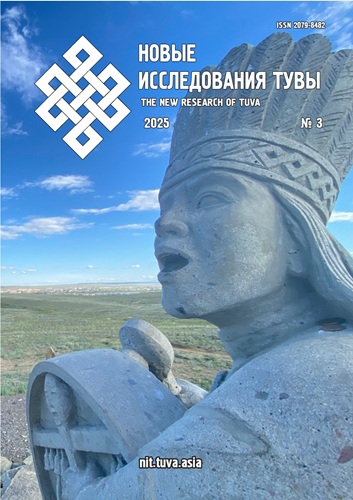School textbooks of Soviet Kazakhstan: visual content and their role in ideological education
DOI:
https://doi.org/10.25178/nit.2025.3.30Keywords:
school textbook; illustration; Soviet ideology; visual content; KazakhstanAbstract
The article analyzes the visual content of school textbooks published in the Kazakh SSR during 1955–1986. In Soviet Kazakhstan, students were educated using both USSR textbooks and those published within the republic. The source base consisted of the textbooks themselves, including “Bukvar” (Alphabet), “History of the USSR”, and “History of the Kazakh SSR”.
The study is grounded in the peculiarities of the Soviet education system, of which the Kazakh system was a part, characterized by a close connection between knowledge and upbringing. Every element of the educational process, including the content and structure of textbooks, was required to conform to the ideological principles of the socialist state. School textbooks became an effective mechanism for indoctrinating Soviet ideals. Visual elements in the textbooks played a significant role in transmitting these principles.
The article presents the regulatory framework governing textbook publications, illustrating the fully state-controlled process.
Analysis revealed that visual images conveyed the ideological values of the specified era: educating students in the spirit of Soviet patriotism, loyalty to the Soviet people, the Communist Party, and the Soviet government; nurturing the spirit of friendship among peoples and proletarian internationalism. The visual information was aimed at shaping the Soviet person with corresponding values.
In Kazakh textbooks, following the pattern of union-wide ones, the oppressive pre-revolutionary period contrasted with the prosperous Soviet era. These textbooks also contained local specifics: depiction of traditional life, symbols, images, and portraits of Kazakh figures.
References
Abylkhozhin, Zh. B. and Krupko, I. V. (2021) Alma-Ata: some architectural narratives of the Soviet city. Vestnik ENU im. L. N. Gumileva. Seriya: Istoricheskie nauki. Filosofiya. Religiozvedenie, no. 1(134), pp. 10–21. (In Russ.) DOI: https://doi.org/10.32523/2616-7255-2021-134-1-10-21
Dalaeva, T. (2024) Audiovisual plots of social history and cultural memory of Kazakh society (late 19th — early 21st centuries). Almaty, Press Co. 320 p. (In Russ.)
Devyataikina, N. I. (2017) Visual sources on medieval history in school textbooks: ways of representation and approaches to their reformatting. Prepodavatel XXI veka, no. 4, part 2, pp. 300–311. (In Russ.)
Efimova, E. A. (2019) Illustrations in primers and alphabets of the 1900s–1920s as a source of visual information on the history of play culture. In: E. A. Vorontsova (comp.) & A. G. Golikov (ed.). The role of visual sources in the information support of historical science: collection of articles. Moscow, INION RAN. 1030 p. Pp. 462–477. (In Russ.)
Zhusupbekova, B. A. (2015) From the history of the formation of the Kazakh alphabet book. Innovatsionnaya nauka, no. 5, pp. 39–41. (In Russ.)
Krikh, S. B. (2017) Pictures in the book: the visual series in Soviet school textbooks on ancient history. Scripta Antiqua. Voprosy drevney istorii, filologii, iskusstva i materialnoy kultury, vol. VI, pp. 359–378. (In Russ.)
Kupriyanova, T. G. (2024) Structural and content features of Soviet primer books. Sfera kultury, no. 1(15), pp. 111–120. (In Russ.) DOI: https://doi.org/10.48164/2713-301X_2024_15_111
Larin, I. N. (2020) Primers and alphabet books of 1918–1930 as a tool for spreading Soviet ideology. Vremya nauki, no. 2, pp. 69–81. (In Russ.)
Pirs, Ch. (2009) What is a sign? / trans. from English by A. A. Argamakova. Vestnik Tomskogo gosudarstvennogo universiteta. Seriya: Filosofiya. Sotsiologiya. Politologiya, no. 3(7), pp. 88–96. (In Russ.)
Rozhkov, A. Yu. (2017) School primer as a channel of educational and propaganda discourse: techniques of indoctrination of “Sovietness” in 1927–1932. In: N. A. Volynchik (ed.). Culture and power in the USSR. 1920–1950s: materials of the IX international scientific conference. Moscow, Politicheskaya entsiklopediya, 741 p. Pp. 355–368. (In Russ.)
Romashina, E. Yu. (2014) Interrelations of text and visual series in Russian school textbooks at the turn of the 19th–20th centuries. Problemy sovremennogo obrazovaniya, no. 6, pp. 135–148. (In Russ.)
Chetyrova, L. B. and Sergeeva, N. M. (2022) Soviet modernity in visual perspective (on the example of Oirats-Kalmyks and Tuvans). New Research of Tuva, no. 2, pp. 239–262. (In Russ.) DOI: https://doi.org/10.25178/nit.2022.2.17
Shtompka, P. (2007) Visual sociology. Photography as a research method / trans. from Polish by N. V. Morozova, intro. by N. E. Pokrovskiy. Moscow, Logos. 168 p. (In Russ.)
Clarke, J. and Seksenbayeva, G. (2018) Visualizing history: The ‘soviet Kazakhstan’ newsreel series. Historical Journal of Film, Radio and Television, no. 38(2), pp. 263–273.
Mitchell, W. J. T. (1995) What is Visual Culture? In: Meaning in the Visual Arts: Views from the Outside / ed. by I. Lavin. Princeton, NJ., Institute for Advanced Study. 399 р. Pp. 207–217.
Published
How to Cite
For citation:
Bekmagambetov R. K., Bekmagambetova M. Zh. and Bimoldanova A. A. School textbooks of Soviet Kazakhstan: visual content and their role in ideological education. New Research of Tuva, 2025, no. 3, pp. 486-508. DOI: https://doi.org/10.25178/nit.2025.3.30
Issue
Section

This work is licensed under a Creative Commons Attribution-NonCommercial 4.0 International License.

Author(s) license holder(s) grant rights for their work to the journal (grantee of a license) under the simple non-exclusive open license in accordance with Art. 1286.1 «Open license for a research work, work of literature or fine arts», Civil Code of the Russian Federation.
New Research of Tuva publishes articles under the Creative Commons Attribution-NonCommercial license (CC BY-NC).
Since it is an open license, author(s) reserve the right to upload the article to their institutional repository, submit it to another journal (if it allows republications), or republish it on their own website (in full, or in part).
However, several conditions apply here:
a) The republished version must always contain the name(s) and affiliation(s) of the author(s), the original title and the hyperlink to the original version on the New Research of Tuva website;
b) It must be in open access, free of charge, and no category of readers must be in any way whatsoever advantaged over general readership.
c) should the contribution be submitted elsewhere by its author(s) without substantial modification (30% or more of original text unchanged), the body of the article should contain a disclaimer that the original version was published in New Research of Tuva (with a link to the respective page)
The CC-BY-NC is a non-revocable license which applies worldwide and lasts for the duration of the work’s copyright.











